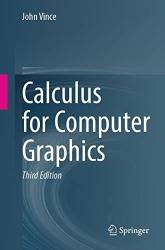Calculus for Computer Graphics, 3rd Edition
- Добавил: literator
- Дата: 21-04-2023, 16:48
- Комментариев: 0
 Название: Calculus for Computer Graphics, 3rd Edition
Название: Calculus for Computer Graphics, 3rd EditionАвтор: John Vince
Издательство: Springer
Год: 2023
Страниц: 387
Язык: английский
Формат: pdf (true), epub
Размер: 60.1 MB
Students studying different branches of computer graphics need to be familiar with geometry, matrices, vectors, rotation transforms, quaternions, curves and surfaces. And as computer graphics software becomes increasingly sophisticated, calculus is also being used to resolve its associated problems. The objective of the book remains the same: to inform the reader about functions and their derivatives, and the inverse process: integration, which can be used for computing area and volume. The emphasis on geometry gives the book relevance to the computer graphics community and hopefully will provide the mathematical background for professionals working in computer animation, games and allied disciplines to read and understand other books and technical papers where the differential and integral notation is found.
In this 3rd edition, the author extends the scope of the original book to include vector differential operators and differential equations and draws upon his experience in teaching mathematics to undergraduates to make calculus appear no more challenging than any other branch of mathematics. He introduces the subject by examining how functions depend upon their independent variables, and then derives the appropriate mathematical underpinning and definitions. This gives rise to a function’s derivative and its antiderivative, or integral. Using the idea of limits, the reader is introduced to derivatives and integrals of many common functions. Other chapters address higher-order derivatives, partial derivatives, Jacobians, vector-based functions, single, double and triple integrals, with numerous worked examples and almost two hundred colour illustrations.
The book divides into 18 chapters, with the obligatory chapters to introduce and conclude the book. Chapter 2 reviews the ideas of functions, their notation and the different types encountered in everyday mathematics. This can be skipped by readers already familiar with the subject.
Chapter 3 introduces the idea of limits and derivatives, and how mathematicians have adopted limits in preference to infinitesimals. Most authors introduce integration as a separate subject, but I have included it in this chapter so that it is seen as an antiderivative, rather than something independent.
Chapter 4 looks at derivatives and antiderivatives for a wide range of functions such as polynomial, trigonometric, exponential and logarithmic. It also shows how function sums, products, quotients and function of a function are differentiated.
Chapter 5 covers higher derivatives and how they are used to detect a local maximum and minimum.
Chapter 6 covers partial derivatives, which although easy to understand, have a reputation for being difficult. This is possibly due to the symbols used, rather than the underlying mathematics. The total derivative is introduced here as it is required in a later chapter.
This book complements the author’s other books on mathematics for computer graphics and assumes that the reader is familiar with everyday algebra, trigonometry, vectors and determinants. After studying this book, the reader should understand calculus and its application within the world of computer graphics, games and animation.
Who Else Should Read This Book?
Who else should read this book? I would say that almost anyone could read this book. Basically, calculus is needed by mathematicians, scientists, physicists, engineers, etc., and this book is just an introduction to the subject, with a bias towards computer graphics.
Contents:
Скачать Calculus for Computer Graphics, 3rd Edition
[related-news] [/related-news]
Внимание
Уважаемый посетитель, Вы зашли на сайт как незарегистрированный пользователь.
Мы рекомендуем Вам зарегистрироваться либо войти на сайт под своим именем.
Уважаемый посетитель, Вы зашли на сайт как незарегистрированный пользователь.
Мы рекомендуем Вам зарегистрироваться либо войти на сайт под своим именем.

